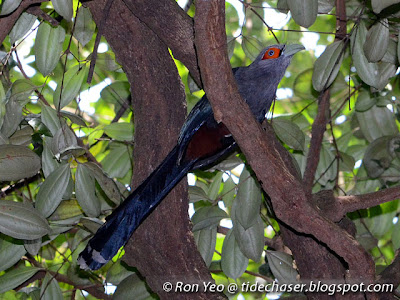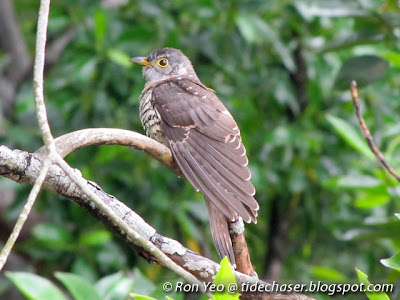Cuculiform birds (phylum Chordata, subphylum Vertebrata, superclass Tetrapoda, class Aves, order Cuculiformes) are mostly birds with streamlined bodies, stout beaks and longish tails. In Singapore, they are represented by the cuckoos (family Cuculidae). Many of the species are brood parasites, meaning that they lay their eggs in the nests of other bird species, and the latter will help incubate the eggs and take care of the chicks after they are hatched.
Here are some of the cuckoos that I have seen in Singapore.

The Little Bronze Cuckoo (Chrysococcyx minutillus) is a common resident bird that can be seen in secondary forests, coastal forests and wooded areas. This small cuckoo gets to about 16cm long, and it can be recognised by its greenish brown back and barred underside. The male, featured in the photo above, has red eye rings.

The female looks similar, but has yellowish eye rings instead. Little Bronze Cuckoos feed on insects. In Singapore, they have been observed to lay their eggs in the nests of the Golden-bellied Gerygone (Gerygone sulphurea).

The Greater Coucal (Centropus sinensis) is an uncommon resident bird that is usually seen in wooded areas, scrublands, and secondary forests. It has a glossy black head and body, and brownish orange wings. The adults reach lengths of about 45cm. It can be confused with the Lesser Coucal (Centropus bengalensis), but the latter prefers more open areas, is smaller, and has pale streaks on the wings and body. The coucals are non-parasitic, unlike many other cuckoo species. They feed on insects and small vertebrates.

The Chestnut-bellied Malkoha (Phaenicophaeus sumatranus) is an uncommon resident bird that lives in the forest, usually in the canopy. This cuckoo can be easily recognised by the orange eye patch, purplish head, bluish green wings and tail, and chestnut belly. It is non-parasitic. The adult bird is about 40cm long, and feeds mostly on insects.

The Asian Drongo Cuckoo (Surniculus lugubris) is an uncommon resident cuckoo that resembles a drongo, with its black plumage and forked tail. It can be seen in inland forests, gardens and mangroves. The adult is about 25cm long. This species has been observed to parasitise on babblers.

The Chestnut-winged Cuckoo (Clamator coromandus) is an uncommon winter visitor that is sometimes seen in the forests, mangroves and wooded areas. It can be recognised by the black head with a prominent crest, orange throat, white belly, chestnut wing and black tail. The adult is about 45cm long. It has been observed to lay its eggs in the nests of laughing-thrushes.

The Indian Cuckoo (Cuculus micropterus) is a common winter visitor that can be seen in forests, mangroves and wooded areas. It has yellow eye rings, brown wings and back, a greyish head, and a white belly mark with black stripes. The adult gets to about 30cm long. It has been observed to lay its eggs in the nests of crows and drongos. This species feeds mostly on insects.

The Hodgson's Hawk Cuckoo (Cuculus nisicolor) is an uncommon winter visitor that is usually seen in the forest or wooded areas. It has yellow eye rings, a greyish brown head, greyish brown wings, whitish underside with dark streaks, and dark bars on the underside of the wings and the tail. It grows to about 30cm long, and has been observed to lay its eggs in the nests of flycatchers.

The Asian Koel (Eudynamys scolopacea) used to be just a winter visitor, but has become a resident bird in the 1980s. It is very common in Singapore now, and can be seen in forests, wooded areas, parks and gardens. This species has gotten its common name from one of its call, which sounds very much like "ko-el". The male has a black plumage and red eyes.

The female Asian Koel is brownish marked with whitish patterns. The adult grows to about 45cm long, and feeds on insects and small vertebrate. It lays its eggs mostly in the nests of crows - possibly a reason for the increasing population since the latter are rather abundant in Singapore.
References
Here are some of the cuckoos that I have seen in Singapore.

The Little Bronze Cuckoo (Chrysococcyx minutillus) is a common resident bird that can be seen in secondary forests, coastal forests and wooded areas. This small cuckoo gets to about 16cm long, and it can be recognised by its greenish brown back and barred underside. The male, featured in the photo above, has red eye rings.

The female looks similar, but has yellowish eye rings instead. Little Bronze Cuckoos feed on insects. In Singapore, they have been observed to lay their eggs in the nests of the Golden-bellied Gerygone (Gerygone sulphurea).

The Greater Coucal (Centropus sinensis) is an uncommon resident bird that is usually seen in wooded areas, scrublands, and secondary forests. It has a glossy black head and body, and brownish orange wings. The adults reach lengths of about 45cm. It can be confused with the Lesser Coucal (Centropus bengalensis), but the latter prefers more open areas, is smaller, and has pale streaks on the wings and body. The coucals are non-parasitic, unlike many other cuckoo species. They feed on insects and small vertebrates.

The Chestnut-bellied Malkoha (Phaenicophaeus sumatranus) is an uncommon resident bird that lives in the forest, usually in the canopy. This cuckoo can be easily recognised by the orange eye patch, purplish head, bluish green wings and tail, and chestnut belly. It is non-parasitic. The adult bird is about 40cm long, and feeds mostly on insects.

The Asian Drongo Cuckoo (Surniculus lugubris) is an uncommon resident cuckoo that resembles a drongo, with its black plumage and forked tail. It can be seen in inland forests, gardens and mangroves. The adult is about 25cm long. This species has been observed to parasitise on babblers.

The Chestnut-winged Cuckoo (Clamator coromandus) is an uncommon winter visitor that is sometimes seen in the forests, mangroves and wooded areas. It can be recognised by the black head with a prominent crest, orange throat, white belly, chestnut wing and black tail. The adult is about 45cm long. It has been observed to lay its eggs in the nests of laughing-thrushes.

The Indian Cuckoo (Cuculus micropterus) is a common winter visitor that can be seen in forests, mangroves and wooded areas. It has yellow eye rings, brown wings and back, a greyish head, and a white belly mark with black stripes. The adult gets to about 30cm long. It has been observed to lay its eggs in the nests of crows and drongos. This species feeds mostly on insects.

The Hodgson's Hawk Cuckoo (Cuculus nisicolor) is an uncommon winter visitor that is usually seen in the forest or wooded areas. It has yellow eye rings, a greyish brown head, greyish brown wings, whitish underside with dark streaks, and dark bars on the underside of the wings and the tail. It grows to about 30cm long, and has been observed to lay its eggs in the nests of flycatchers.

The Asian Koel (Eudynamys scolopacea) used to be just a winter visitor, but has become a resident bird in the 1980s. It is very common in Singapore now, and can be seen in forests, wooded areas, parks and gardens. This species has gotten its common name from one of its call, which sounds very much like "ko-el". The male has a black plumage and red eyes.

The female Asian Koel is brownish marked with whitish patterns. The adult grows to about 45cm long, and feeds on insects and small vertebrate. It lays its eggs mostly in the nests of crows - possibly a reason for the increasing population since the latter are rather abundant in Singapore.
References
- Briffett, C. 1986. A guide to the common birds of Singapore. Singapore Science Centre. 160 pp.
- Robson, C. 2010. New Holland field guide to the birds of South-East Asia. London: New Holland Publishers. 304 pp.
- Singapore birds. Retrieved Mar 25, 2013, http://singaporebirds.blogspot.sg
- Sreedharan, S. 2010. The birds of Singapore. Retrieved Apr 6, 2013, http://singaporebirds.net
- Strange, M. 2000. Photographic guide to the birds of Southeast Asia. Singapore: Periplus. 398 pp.

No comments:
Post a Comment